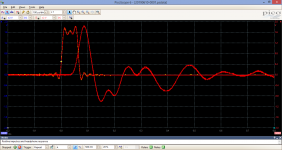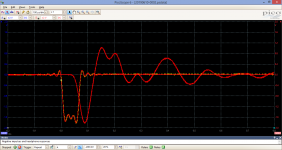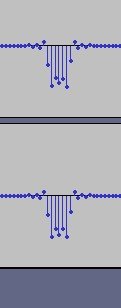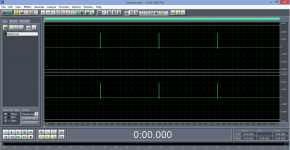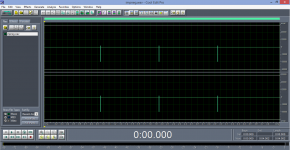This test is intended to check audibility of the absolute phase. There are 2 test files, one of them contains a train of 3 positive impulses, the other one contains the same impulses but inverted in polarity. Impulses are about 60us wide, with rise time and fall time of about 10us. They are in 96kHz/16bit and your sound system must play the files in 96kHz, without resampling to 48 or 44.1kHz.
Please try the files and vote. ABX results are requested in case you would like your result to be considered as serious.
Please try the files and vote. ABX results are requested in case you would like your result to be considered as serious.
Attachments
Please let me start, I have got a 8/8 positive result, repeatedly.
I also have measurements of impulses and of the headphones acoustical output. Headphones are cheap JVC HA-S160.
Code:
foo_abx 2.0.2 report
foobar2000 v1.3.7
2019-06-10 08:35:01
File A: imppos.wav
SHA1: 3a1732c9825156a1509146feb3ad6487462cf6ce
File B: impneg.wav
SHA1: 7a482ace497f95cb64272e62a044aad1d9d9a297
Used DSPs:
Resampler (PPHS)
Output:
WASAPI (event) : Speakers (iConnectAudio4+ D1), 24-bit
Crossfading: NO
08:35:01 : Test started.
08:35:28 : 01/01
08:35:38 : 02/02
08:35:49 : 03/03
08:36:10 : 04/04
08:36:21 : 05/05
08:36:39 : 06/06
08:36:55 : 07/07
08:37:13 : 08/08
08:37:13 : Test finished.
----------
Total: 8/8
Probability that you were guessing: 0.4%
-- signature --
824544950fbccb46a42eb3b58764dafb6ab30343I also have measurements of impulses and of the headphones acoustical output. Headphones are cheap JVC HA-S160.
I can be bothered running Foobar 
Quite a clear difference, one has noticeably more bass impact on each transient, the other sounding a little thin. 1uF coupling cap vs a 0.1uF kind of thing.
Laptop and Sony MDRV-7 headphones.
Quite a clear difference, one has noticeably more bass impact on each transient, the other sounding a little thin. 1uF coupling cap vs a 0.1uF kind of thing.
Laptop and Sony MDRV-7 headphones.
Code:
foo_abx 2.0.5 report
foobar2000 v1.4.2
2019-06-10 08:14:27
File A: impneg.wav
SHA1: 7a482ace497f95cb64272e62a044aad1d9d9a297
File B: imppos.wav
SHA1: 3a1732c9825156a1509146feb3ad6487462cf6ce
Output:
DS : Primary Sound Driver
Crossfading: NO
08:14:27 : Test started.
08:15:50 : 01/01
08:16:01 : 02/02
08:16:11 : 03/03
08:16:37 : 04/04
08:16:45 : 05/05
08:16:52 : 06/06
08:17:00 : 07/07
08:17:07 : 08/08
08:17:07 : Test finished.
----------
Total: 8/8
Probability that you were guessing: 0.4%
-- signature --
1e87e1ebdab793c3da8dc68cabdc65832479219fThe difference is perfectly clear, you can count me as positive result, I can't be bothered running Foobar ABX.
This is obvious test, what's the point, or what's next step ?.
Maybe it is obvious for you, however maybe it is not obvious for everyone. That's why the test is here, and everyone can try in a DBT to exclude possible listener's bias.
I can be bothered running Foobar
Quite a clear difference, one has noticeably more bass impact on each transient, the other sounding a little thin. 1uF coupling cap vs a 0.1uF kind of thing.
Laptop and Sony MDRV-7 headphones.
Thank you for trying the files and congratulations to a positive ABX result, Karl.
If you make a summation of imppos and impneg files, the result is just a residual noise. I agree with your sound description. One sounds with more impact and more full, the other one sounds thinner.
Last edited:
Are you triggering some gross non linearity in the driver? I suspect that dome drive break-up resonances may well rectify the audio pressure waveform
I am not sure, because acoustical measurement from the headphone (mike is about 1.5 - 2cm from the headphone transducer) shows pretty same shapes for the positive and negative responses. Could it be rather ear non-linearity or rather different human ear response to pressure attacks compared to pressure fast decrease?
P.S.: not only oscilloscope plots from headphone record look same, but I have also made a summation of acoustical headphone output recorded from whole imppos and impneg files. The summation has only noise components, looking like 1/f noise, which would be the microphone channel noise and also some ambient room noise. No clicks, no colorations.
Last edited:
With species evolutions, our senses adapted themselves to the best ability to survive. As much of the sounds we hear from movements of animals in nature are the result of shocks (compressions) it seems obvious our hearing could be more sensible to pressure on front waves.I am not sure, because acoustical measurement from the headphone (mike is about 1.5 - 2cm from the headphone transducer) shows pretty same shapes for the positive and negative responses. Could it be rather ear non-linearity or rather different human ear response to pressure attacks compared to pressure fast decrease?
The other thing that can make a difference are the transducers we use. Are-they really symmetrical ? I am not sure ;-)
Anyway, as nobody cares during records processes about absolute phase, they is all the chances to be random. So, it is just enough to have, somewhere in our systems, a phase reverse button to figure out, with real music, if it matters for us or not.
On my side, I don't take care of this, neither, as it seems the difference, if any, is not a problem.
On my side, I don't take care of this, neither, as it seems the difference, if any, is not a problem.
Yes, and a natural sound source never sends out a rarefaction pulse so of course the ear identifies this as unusual or wrong.With species evolutions, our senses adapted themselves to the best ability to survive. As much of the sounds we hear from movements of animals in nature are the result of shocks (compressions) it seems obvious our hearing could be more sensible to pressure on front waves.
The other thing that can make a difference are the transducers we use. Are-they really symmetrical ? I am not sure ;-)
As I have already explained, I have recorded the sound from headphones (playing the test signals), time-aligned them and then made a summation. As they have inverted polarity, there would be some signal difference after summation, if the recorded acoustical impulses were asymmetrical. However, the result is a noise - background room noise, no impulse signal. This says, that the headphones, at least the ones I have used, are able to transfer the symmetry quite faithfully. It is our hearing system that makes a difference. As I told in BT thread, if we hear a difference, it does not necessarily means that the difference exists.
I’m not sure what I’m supposed to hear but 1 sounds sharper/quicker and 2 sounds duller/fuller....all my testing is done with music at lp.....Clicks are not my forte!
The impulses in this test have the same shape.
I’m not sure what I’m supposed to hear but 1 sounds sharper/quicker and 2 sounds duller/fuller....all my testing is done with music at lp.....Clicks are not my forte!
The impulses in this test have the same shape.
So the only difference is polarity?
So the only difference is polarity?
Exactly. You (or any other participant) are asked to say if you hear a difference between imppos (all positive impulses) and impneg (all negative impulses) files and provide an ABX protocol, if you have it.
Attachments
Last edited:
Exactly. You (or any other participant) are asked to say if you hear a difference between imppos (all positive impulses) and impneg (all negative impulses) files and provide an ABX protocol, if you have it.
Well to me the first one is sharper, is that the + one?
I went back and forth without looking at which one it was.....predominantly noticed ‘1’ to be sharper.
Now if your gonna say I’m not supposed to hear a difference, I hate to disappoint.
- Status
- This old topic is closed. If you want to reopen this topic, contact a moderator using the "Report Post" button.
- Home
- General Interest
- Everything Else
- Can you hear absolute phase? - listening test
